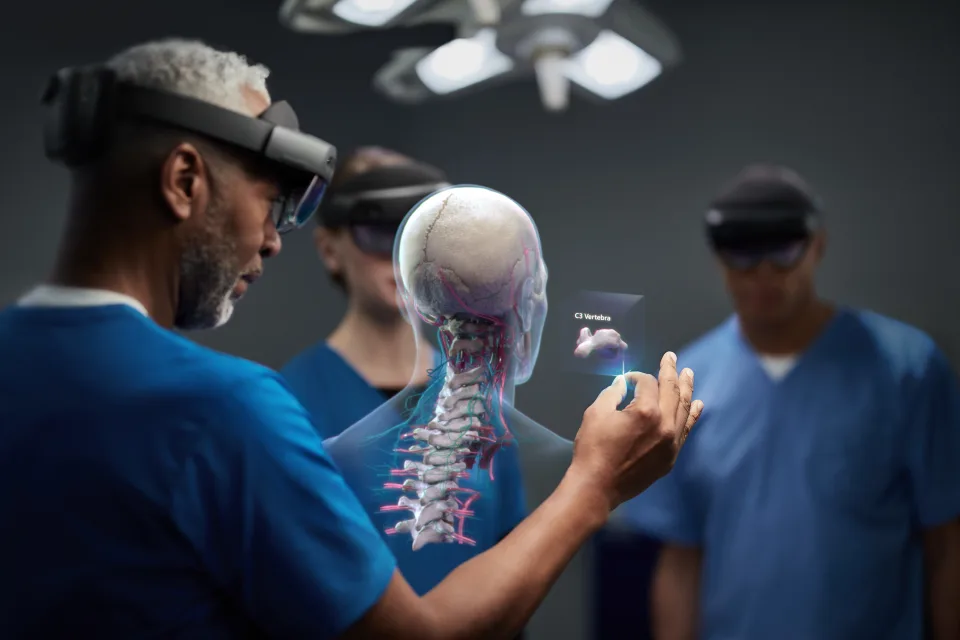
Microsoft's HoloLens 2 used in the operating theater.
Crédits photos : Microsoft
Virtual reality is no longer an anomaly in the medical world. Many articles and scientific studies praise its benefits. The public is increasingly comfortable with these technologies. VR (Virtual Reality) headsets and mobile augmented reality applications have become part of their daily lives. But when you’re a healthcare specialist, it can sometimes seem overwhelming to adopt innovative techniques. This may be due to a lack of time, information or advice, but immersive technologies represent an opportunity in terms of cost, treatment and energy. The challenge has been taken up by a number of practitioners. So who are these professionals? How have they chosen these processes in their profession? What benefits have they gained? Zoom in on practices that are already widespread.
A brief history of virtual reality in the medical sector
The first virtual reality headset appeared in 1968. It was so heavy that it had to be hung by cables! Other solutions were developed using screens. Researchers cover the walls of a room with this technology. These systems are known as CAVEs.
It was in the 90s that scientists became interested in using virtual reality to treat patients suffering from phobias. Despite initial conclusive results, the devices were considered uncomfortable and expensive. Some even felt nauseous when using them.
Today, this technology has been democratised. It has spread to many surgeries and care centres and is combined with other specific features such as artificial intelligence. It can even be used to treat seasickness! It’s a nice twist on a method that used to be considered nauseating.
Innovative technologies used in healthcare
Research has continued to evolve, and IT tools have come up with ever more effective solutions. Over the years, so-called convergent technologies have emerged around virtual reality:
- biometric sensors;
- robotics;
- haptic systems (for a sense of touch);
- drones;
- motion trackers;
- brain computing (calculation of brain activity);
- artificial intelligence…
Each of these advances has increased patients’ sense of immersion. The therapeutic benefits are now considered reliable and proven.
Examples of the use of virtual reality by care professionals
Virtual reality in the operating theater
In February 2024, for the first time in Europe, Professor and surgeon Julien Berhouet is using mixed reality in the operating theater at the CHRU in Tours (France). Using glasses, this technology is a hybrid of virtual reality and augmented reality, with the addition of holograms amongst other features. It offers precise intra-operative guidance and enables implants to be placed as planned. Surgical assistance for both experienced surgeons and recent graduates.
” The human eye can be mistaken by around 10 degrees. And a misaligned implant can lead to a fracture,” the orthopaedic surgeon and traumatologist told journalists. The use of mixed reality in the operating theater reduces the margin of error. In Italy in 2020, a jaw operation was carried out using augmented reality.
Metavers for overcrowded hospitals and medical deserts
Since the pandemic period and in response to saturated hospitals, consultation by videoconferencing has become a common practice. They have enabled doctors to advise, diagnose and prescribe the right treatment for their patients remotely. The French Digital Health Agency has reported an 88% satisfaction rate among the population. We can assuredly say that telemedicine has a bright future ahead of it!
Now imagine these same consultations but in a totally virtual environment in which you can interact with your interlocutor. These are known as medical metaverses. According to some specialists, they could be the next “healthcare revolution”. In the United Kingdom, the Alder Hey children’s hospital opened the digital twin of its radiology department in 2022. CVS Health, a group of pharmacies, has registered trademark rights to market prescription drugs and wellness products in the metaverse.
According to InsightAce Analytic, the medical metaverse is expected to reach $71.2 billion by 2030 (up from $5 billion in 2021).
Virtual reality training for nursing staff
This is one of the most common uses of virtual reality and augmented reality in healthcare. Teaching student nurses how to perform transfusions, simulating dental care, raising patients’ awareness of their health pathway… the list can be so long, the applications are so diverse!
A study published in the Journal of Medical Internet Research has revealed a more complete acquisition of knowledge when using immersive tools. Repetition of movements is the key. Thanks to the integration of related technologies (mentioned above), experiences are multi-sensory. Learners can understand their mistakes and repeat them without any cost constraints.
Virtual reality headsets and augmented reality applications also provide greater access to training. They are so handy that it’s easy to learn remotely. For more case studies, you will find a series of articles on our blog detailing examples of virtual environment training for healthcare professionals.
Artificial intelligence and virtual reality as anxiolytics
It’s the latest major innovation in healthcare: the combination of virtual reality and artificial intelligence. Supported by the French National Centre for Space Studies and ESA, Dr Elise Jabes, a doctor of psychology specialising in stress management in isolated, confined and extreme environments, is the founder of Coreod Space. At the beginning of 2024, she presented S.A.T. (Spatial Adaptive Technology), an immersive system using artificial intelligence to treat anxiety. This virtual reality headset, which combines innovation and mental health, offers:
- improved sleep;
- better stress management;
- an increase in self-confidence.
This protocol has been used with astronauts to work on their well-being. Maintaining a good mental balance for teams in space or on the moon is crucial to their success. This solution stimulates users’ cognitive and neuropsychological functions, helping them to achieve their full potential on their space mission. Far from the stars and on earth, virtual reality has also proved its worth in pre-operative hypnosis, phobia treatment, managing tense situations, correcting post-traumatic disorders, and so on.

How can you adopt virtual reality as a healthcare professional?
Thanks to specialist companies, implementing immersive technology solutions in your care practice is within your reach. There’s no need to know all the technical terms. Some companies offer ready-to-use solutions. The key is to know who to turn to, to avoid falling for tools that are more gadget than therapy. We recommend:
- check the suggested use cases;
- ask for a demonstration of the technology (perhaps on the company’s site or at exhibitions and conferences);
- talk to your contact’s customers;
- if it’s a start-up that hasn’t yet had its first customers, look at the data it relies on;
- ask for the names of the healthcare professionals who validated the experience, whenever possible.
If you have a specific need and can’t find the right application for you, we invite you to talk to the experts in the sector. You could give them the idea for new uses! That’s one of the exciting opportunities we see every year at our annual exhibition dedicated to virtual technologies. One meeting, one exchange: a new innovation emerges a few months later.
And to make the most of your time, we look forward to seeing you at our next event. Every year, Laval Virtual brings together the major players in virtual reality, giving you the chance to test and be inspired in the same place. If, despite everything, you don’t know where to start, we invite you to take part in the personalised tours of the event with a dedicated guide who will be able to point you in the right direction.


